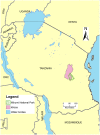Dengue and Chikungunya fever among viral diseases in outpatient febrile children in Kilosa district hospital, Tanzania
- PMID: 25412076
- PMCID: PMC4239002
- DOI: 10.1371/journal.pntd.0003335
Dengue and Chikungunya fever among viral diseases in outpatient febrile children in Kilosa district hospital, Tanzania
Abstract
Introduction: Viral etiologies of fever, including dengue, Chikungunya, influenza, rota and adeno viruses, cause major disease burden in tropical and subtropical countries. The lack of diagnostic facilities in developing countries leads to failure to estimate the true burden of such illnesses, and generally the diseases are underreported. These diseases may have similar symptoms with other causes of acute febrile illnesses including malaria and hence clinical diagnosis without laboratory tests can be difficult. This study aimed to identify viral etiologies as a cause of fever in children and their co-infections with malaria.
Methods: A cross sectional study was conducted for 6 months at Kilosa district hospital, Tanzania. The participants were febrile children aged 2-13 years presented at the outpatient department. Diagnostic tests such as IgM and IgG ELISA, and PCR were used.
Results: A total of 364 patients were enrolled, of these 83(22.8%) had malaria parasites, 76 (20.9%) had presumptive acute dengue infection and among those, 29(38.2%) were confirmed cases. Dengue was more likely to occur in children ≥ 5 years than in <5 years (OR 2.28, 95% CI: 1.35-3.86). Presumptive acute Chikungunya infection was identified in 17(4.7%) of patients. We observed no presenting symptoms that distinguished patients with Chikungunya infection from those with dengue infection or malaria. Co-infections between malaria and Chikungunya, malaria and dengue fever as well as Chikungunya and dengue were detected. Most patients with Chikungunya and dengue infections were treated with antibacterials. Furthermore, our results revealed that 5(5.2%) of patients had influenza virus while 5(12.8%) had rotavirus and 2(5.1%) had adenovirus.
Conclusion: Our results suggest that even though viral diseases are a major public health concern, they are not given due recognition as a cause of fever in febrile patients. Emphasis on laboratory diagnostic tests for proper diagnosis and management of febrile patients is recommended.
Conflict of interest statement
The authors have declared that no competing interests exist.
Figures
Similar articles
-
Prevalence of dengue and chikungunya virus infections in north-eastern Tanzania: a cross sectional study among participants presenting with malaria-like symptoms.BMC Infect Dis. 2016 Apr 26;16:183. doi: 10.1186/s12879-016-1511-5. BMC Infect Dis. 2016. PMID: 27112553 Free PMC article.
-
Prevalence of bacterial febrile illnesses in children in Kilosa district, Tanzania.PLoS Negl Trop Dis. 2015 May 8;9(5):e0003750. doi: 10.1371/journal.pntd.0003750. eCollection 2015 May. PLoS Negl Trop Dis. 2015. PMID: 25955522 Free PMC article.
-
Comparison of clinical presentation and out-comes of Chikungunya and Dengue virus infections in patients with acute undifferentiated febrile illness from the Sindh region of Pakistan.PLoS Negl Trop Dis. 2020 Mar 23;14(3):e0008086. doi: 10.1371/journal.pntd.0008086. eCollection 2020 Mar. PLoS Negl Trop Dis. 2020. PMID: 32203509 Free PMC article.
-
Dengue and Chikungunya Infections in Children : Guest Editor: Bhim S. Pandhi.Indian J Pediatr. 2019 Mar;86(3):287-295. doi: 10.1007/s12098-018-2794-x. Epub 2018 Dec 4. Indian J Pediatr. 2019. PMID: 30511272 Review.
-
Co-distribution and co-infection of chikungunya and dengue viruses.BMC Infect Dis. 2016 Mar 3;16:84. doi: 10.1186/s12879-016-1417-2. BMC Infect Dis. 2016. PMID: 26936191 Free PMC article. Review.
Cited by
-
Antibodies against medically relevant arthropod-borne viruses in the ubiquitous African rodent Mastomys natalensis.PLoS Negl Trop Dis. 2024 Sep 4;18(9):e0012233. doi: 10.1371/journal.pntd.0012233. eCollection 2024 Sep. PLoS Negl Trop Dis. 2024. PMID: 39231158 Free PMC article.
-
Dengue Virus Infection and Associated Risk Factors in Africa: A Systematic Review and Meta-Analysis.Viruses. 2021 Mar 24;13(4):536. doi: 10.3390/v13040536. Viruses. 2021. PMID: 33804839 Free PMC article.
-
Clinical profile of dengue fever and coinfection with chikungunya.Tzu Chi Med J. 2018 Jul-Sep;30(3):158-164. doi: 10.4103/tcmj.tcmj_138_17. Tzu Chi Med J. 2018. PMID: 30069124 Free PMC article.
-
Chikungunya Virus Infections Among Patients with Dengue-Like Illness at a Tertiary Care Hospital in the Philippines, 2012-2013.Am J Trop Med Hyg. 2015 Dec;93(6):1318-24. doi: 10.4269/ajtmh.15-0332. Epub 2015 Sep 28. Am J Trop Med Hyg. 2015. PMID: 26416109 Free PMC article.
-
Epidemic risk of arboviral diseases: Determining the habitats, spatial-temporal distribution, and abundance of immature Aedes aegypti in the Urban and Rural areas of Zanzibar, Tanzania.PLoS Negl Trop Dis. 2020 Dec 7;14(12):e0008949. doi: 10.1371/journal.pntd.0008949. eCollection 2020 Dec. PLoS Negl Trop Dis. 2020. PMID: 33284806 Free PMC article.
References
-
- WHO (2011) The top 10 causes of death: The 10 leading causes of death in the world, 2000 and 2011.
-
- Greenwood B, Mutabingwa T (2002) Malaria in 2002. Nature 415: 670–672. - PubMed
-
- WHO (2012) World Malaria Report. World Health Organization. Geneva.
Publication types
MeSH terms
LinkOut - more resources
Full Text Sources
Other Literature Sources
Medical


